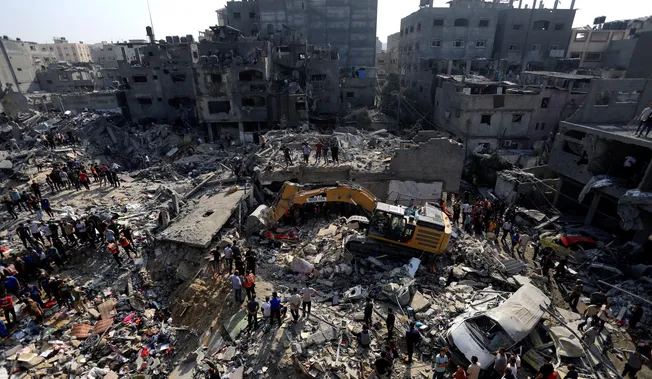A Hamas terrorist was taken out of the debris, carried in his father’s arms. His face is covered with dust, his body jerking like a sack, his stare blank. It’s not clear if he’s alive or dead. He is a toddler of three or four, and his desperate father rushed him to the Gaza Strip’s Indonesian Hospital, which was already bursting with wounded and dead people.

Another terrorist was extracted from the wreckage. This time she’s clearly alive, her fair, curly hair is white with dust; she’s five or six, being carried by her father. She looks right and left, as though asking where help will come from.
A man in a tattered vest scribbles here and there, a white sheet folded like a shroud in his hands, covering an infant’s body, and he’s waving it in despair. It’s the body of his son, a newborn baby. This infant hadn’t yet had a chance to join Hamas’ military headquarters in the Jabalya refugee camp. He had only lived a few days – a butterfly’s eternity – and was killed.
Dozens of youngsters continued digging in the rubble with their bare hands in a desperate effort to extract still-living people or the bodies of neighbors, raising destroyed walls from the hand of a child sticking out of the ruins. Perhaps this child was a terrorist in Hamas’ Nukhba force.
All around stood hundreds of men, dressed in rags, clasping their hands together hopelessly. Some of them burst into tears. An Israeli solar heater with a Hebrew sticker lies in the rubble, a reminder of days gone by. “We have no time for feelings now,” says camp resident Mansour Shimal to Al Jazeera.
On Tuesday afternoon, Israel Air Force jets bombed Block 6 in the Jabalya refugee camp. In Israel, it was barely reported. Al Jazeera reported that six bombs had been dropped on Block 6, leaving a huge crater, into which a row of gray apartment buildings fell like a house of cards. The pilots must have reported successful hits. The sights were horrific.
When I went to Gaza’s Daraj Quarter in July 2002, the day after Salah Shehadeh’s assassination, I saw harsh sights. But they were pastoral compared to what was seen in Jabalya on Tuesday. In Daraj, 14 civilians were killed, 11 of them children – about a tenth of the number of people killed in the bombing on Tuesday in Jabalya, according to Palestinian reports.
In Israel, they didn’t show the Jabalya scenes. And yet, hard to believe, they did take place. A few foreign networks broadcast them in a loop. In Israel, they said the commander of Hamas’ central battalion in Jabalya, Ibrahim Biari, was killed in an air force strike in the most crowded refugee camp in Gaza and that dozens of terrorists had been killed. Shehadeh’s killing was followed by a penetrating public debate in Israel.
What took place on Tuesday in Jabalya was barely even heard about here. It happened before the bad news about the Israeli soldiers who were killed was released, while the wartime campfire was crackling away.
According to the reports, about 100 people were killed in the Jabalya bombing and some 400 were wounded. The pictures from the Indonesian Hospital were horrifying, no less. Burnt children thrown one beside another, three and four on one filthy bed; most of them were treated on the floor for lack of enough beds. “Treatment” is the wrong word. Due to the lack of medicines, life-saving surgery was carried out not only on the floor, but without anesthesia. The Indonesian Hospital in Beit Lahia is now a hell.
Israel is at war, after Hamas murdered and kidnapped with barbarism and brutality that cannot be forgiven. But the children who were extracted from the debris of Block 6 and some of their parents have nothing to do with the attacks on Be’eri and Sderot.
While the terrorists ran rampant in Israel, Jabalya’s people were huddled in their huts in Gaza’s most crowded camp, thinking how to pass another day in these conditions, which were worsened by the siege of the last 16 years. Now they will bury their children in mass graves because in Jabalya, there’s no room left for individual ones.
